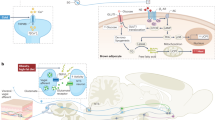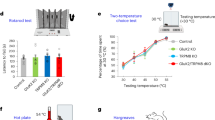Abstract
Defending body temperature against environmental thermal challenges is one of the most fundamental homeostatic functions that are governed by the nervous system. Here we describe a somatosensory pathway that essentially constitutes the afferent arm of the thermoregulatory reflex that is triggered by cutaneous sensation of environmental temperature changes. Using in vivo electrophysiological and anatomical approaches in the rat, we found that lateral parabrachial neurons are pivotal in this pathway by glutamatergically transmitting cutaneous thermosensory signals received from spinal somatosensory neurons directly to the thermoregulatory command center, the preoptic area. This feedforward pathway mediates not only sympathetic and shivering thermogenic responses but also metabolic and cardiac responses to skin cooling challenges. Notably, this 'thermoregulatory afferent' pathway exists in parallel with the spinothalamocortical somatosensory pathway that mediates temperature perception. These findings make an important contribution to our understanding of both the somatosensory system and thermal homeostasis—two mechanisms that are fundamental to the nervous system and to our survival.
This is a preview of subscription content, access via your institution
Access options
Subscribe to this journal
Receive 12 print issues and online access
$209.00 per year
only $17.42 per issue
Buy this article
- Purchase on Springer Link
- Instant access to full article PDF
Prices may be subject to local taxes which are calculated during checkout





Similar content being viewed by others
References
Hammel, H.T. Regulation of internal body temperature. Annu. Rev. Physiol. 30, 641–710 (1968).
Hensel, H. Thermoreception and temperature regulation. Monogr. Physiol. Soc. 38, 1–321 (1981).
Boulant, J.A. & Gonzalez, R.R. The effect of skin temperature on the hypothalamic control of heat loss and heat production. Brain Res. 120, 367–372 (1977).
Nagashima, K., Nakai, S., Tanaka, M. & Kanosue, K. Neuronal circuitries involved in thermoregulation. Auton. Neurosci. 85, 18–25 (2000).
Nakamura, K. & Morrison, S.F. Central efferent pathways mediating skin cooling-evoked sympathetic thermogenesis in brown adipose tissue. Am. J. Physiol. Regul. Integr. Comp. Physiol. 292, R127–R136 (2007).
Romanovsky, A.A. Thermoregulation: some concepts have changed. Functional architecture of the thermoregulatory system. Am. J. Physiol. Regul. Integr. Comp. Physiol. 292, R37–R46 (2007).
Huckaba, C.E., Downey, J.A. & Darling, R.C. A feedback-feedforward mechanism describing the interaction of central and peripheral signals in human thermoregulation. Int. J. Biometeorol. 15, 141–145 (1971).
Savage, M.V. & Brengelmann, G.L. Control of skin blood flow in the neutral zone of human body temperature regulation. J. Appl. Physiol. 80, 1249–1257 (1996).
Craig, A.D., Bushnell, M.C., Zhang, E-T. & Blomqvist, A. A thalamic nucleus specific for pain and temperature sensation. Nature 372, 770–773 (1994).
Craig, A.D. How do you feel? Interoception: the sense of the physiological condition of the body. Nat. Rev. Neurosci. 3, 655–666 (2002).
Sagar, S.M., Sharp, F.R. & Curran, T. Expression of c-fos protein in brain: metabolic mapping at the cellular level. Science 240, 1328–1331 (1988).
Saper, C.B. & Loewy, A.D. Efferent connections of the parabrachial nucleus in the rat. Brain Res. 197, 291–317 (1980).
Fulwiler, C.E. & Saper, C.B. Subnuclear organization of the efferent connections of the parabrachial nucleus in the rat. Brain Res. Rev. 7, 229–259 (1984).
Krukoff, T.L., Harris, K.H. & Jhamandas, J.H. Efferent projections from the parabrachial nucleus demonstrated with the anterograde tracer Phaseolus vulgaris leucoagglutinin. Brain Res. Bull. 30, 163–172 (1993).
Bester, H., Besson, J-M. & Bernard, J-F. Organization of efferent projections from the parabrachial area to the hypothalamus: a Phaseolus vulgaris-leucoagglutinin study in the rat. J. Comp. Neurol. 383, 245–281 (1997).
Lumpkin, E.A. & Caterina, M.J. Mechanisms of sensory transduction in the skin. Nature 445, 858–865 (2007).
Cechetto, D.F., Standaert, D.G. & Saper, C.B. Spinal and trigeminal dorsal horn projections to the parabrachial nucleus in the rat. J. Comp. Neurol. 240, 153–160 (1985).
Bernard, J.-F., Dallel, R., Raboisson, P., Villanueva, L. & Le Bars, D. Organization of the efferent projections from the spinal cervical enlargement to the parabrachial area and periaqueductal gray: a PHA-L study in the rat. J. Comp. Neurol. 353, 480–505 (1995).
Feil, K. & Herbert, H. Topographic organization of spinal and trigeminal somatosensory pathways to the rat parabrachial and Kölliker-Fuse nuclei. J. Comp. Neurol. 353, 506–528 (1995).
Bester, H., Menendez, L., Besson, J.M. & Bernard, J.F. Spino(trigemino)parabrachiohypothalamic pathway: electrophysiological evidence for an involvement in pain processes. J. Neurophysiol. 73, 568–585 (1995).
Johnston, G.A.R. GABAA receptor pharmacology. Pharmacol. Ther. 69, 173–198 (1996).
Nakamura, K. et al. The rostral raphe pallidus nucleus mediates pyrogenic transmission from the preoptic area. J. Neurosci. 22, 4600–4610 (2002).
Madden, C.J. & Morrison, S.F. Excitatory amino acid receptor activation in the raphe pallidus area mediates prostaglandin-evoked thermogenesis. Neuroscience 122, 5–15 (2003).
Zaretskaia, M.V., Zaretsky, D.V. & DiMicco, J.A. Role of the dorsomedial hypothalamus in thermogenesis and tachycardia caused by microinjection of prostaglandin E2 into the preoptic area in anesthetized rats. Neurosci. Lett. 340, 1–4 (2003).
Madden, C.J. & Morrison, S.F. Excitatory amino acid receptors in the dorsomedial hypothalamus mediate prostaglandin-evoked thermogenesis in brown adipose tissue. Am. J. Physiol. Regul. Integr. Comp. Physiol. 286, R320–R325 (2004).
Nakamura, K. Fever-inducing sympathetic neural pathways. J. Therm. Biol. 29, 339–344 (2004).
Nakamura, K., Matsumura, K., Kobayashi, S. & Kaneko, T. Sympathetic premotor neurons mediating thermoregulatory functions. Neurosci. Res. 51, 1–8 (2005).
Nakamura, Y. et al. Direct pyrogenic input from prostaglandin EP3 receptor–expressing preoptic neurons to the dorsomedial hypothalamus. Eur. J. Neurosci. 22, 3137–3146 (2005).
Gauriau, C. & Bernard, J.-F. A comparative reappraisal of projections from the superficial laminae of the dorsal horn in the rat: the forebrain. J. Comp. Neurol. 468, 24–56 (2004).
Zhang, X., Davidson, S. & Giesler, G.J., Jr. Thermally identified subgroups of marginal zone neurons project to distinct regions of the ventral posterior lateral nucleus in rats. J. Neurosci. 26, 5215–5223 (2006).
Kobayashi, A. & Osaka, T. Involvement of the parabrachial nucleus in thermogenesis induced by environmental cooling in the rat. Pflugers Arch. 446, 760–765 (2003).
Hylden, J.L.K., Anton, F. & Nahin, R.L. Spinal lamina I projection neurons in the rat: collateral innervation of parabrachial area and thalamus. Neuroscience 28, 27–37 (1989).
Broman, J. & Ottersen, O.P. Cervicothalamic tract terminals are enriched in glutamate-like immunoreactivity: an electron microscopic double-labeling study in the cat. J. Neurosci. 12, 204–221 (1992).
Blomqvist, A., Ericson, A.C., Craig, A.D. & Broman, J. Evidence for glutamate as a neurotransmitter in spinothalamic tract terminals in the posterior region of owl monkeys. Exp. Brain Res. 108, 33–44 (1996).
Bratincsák, A. & Palkovits, M. Evidence that peripheral rather than intracranial thermal signals induce thermoregulation. Neuroscience 135, 525–532 (2005).
Chen, X.-M., Hosono, T., Yoda, T., Fukuda, Y. & Kanosue, K. Efferent projection from the preoptic area for the control of non-shivering thermogenesis in rats. J. Physiol. (Lond.) 512, 883–892 (1998).
Nakamura, K. et al. Immunocytochemical localization of prostaglandin EP3 receptor in the rat hypothalamus. Neurosci. Lett. 260, 117–120 (1999).
Lazarus, M. et al. EP3 prostaglandin receptors in the median preoptic nucleus are critical for fever responses. Nat. Neurosci. 10, 1131–1133 (2007).
Bester, H., Chapman, V., Besson, J.-M. & Bernard, J.-F. Physiological properties of the lamina I spinoparabrachial neurons in the rat. J. Neurophysiol. 83, 2239–2259 (2000).
Craig, A.D. & Dostrovsky, J.O. Differential projections of thermoreceptive and nociceptive lamina I trigeminothalamic and spinothalamic neurons in the cat. J. Neurophysiol. 86, 856–870 (2001).
Boulant, J.A. & Hardy, J.D. The effect of spinal and skin temperatures on the firing rate and thermosensitivity of preoptic neurones. J. Physiol. (Lond.) 240, 639–660 (1974).
Hellon, R.F., Hensel, H. & Schäfer, K. Thermal receptors in the scrotum of the rat. J. Physiol. (Lond.) 248, 349–357 (1975).
Saper, C.B. The central autonomic nervous system: conscious visceral perception and autonomic pattern generation. Annu. Rev. Neurosci. 25, 433–469 (2002).
Hori, T., Nakashima, T., Koga, H., Kiyohara, T. & Inoue, T. Convergence of thermal, osmotic and cardiovascular signals on preoptic and anterior hypothalamic neurons in the rat. Brain Res. Bull. 20, 879–885 (1988).
Morrison, S.F. Central pathways controlling brown adipose tissue thermogenesis. News Physiol. Sci. 19, 67–74 (2004).
Nakamura, K. et al. Identification of sympathetic premotor neurons in medullary raphe regions mediating fever and other thermoregulatory functions. J. Neurosci. 24, 5370–5380 (2004).
Nakamura, K. et al. Immunohistochemical localization of prostaglandin EP3 receptor in the rat nervous system. J. Comp. Neurol. 421, 543–569 (2000).
Nakamura, K., Li, Y.-Q., Kaneko, T., Katoh, H. & Negishi, M. Prostaglandin EP3 receptor protein in serotonin and catecholamine cell groups: a double immunofluorescence study in the rat brain. Neuroscience 103, 763–775 (2001).
Morrison, S.F. & Cao, W.-H. Different adrenal sympathetic preganglionic neurons regulate epinephrine and norepinephrine secretion. Am. J. Physiol. Regul. Integr. Comp. Physiol. 279, R1763–R1775 (2000).
Pinault, D. A novel single-cell staining procedure performed in vivo under electrophysiological control: morpho-functional features of juxtacellularly labeled thalamic cells and other central neurons with biocytin or Neurobiotin. J. Neurosci. Methods 65, 113–136 (1996).
Acknowledgements
We thank Y. Nakamura for discussion and assistance. This work was supported by US National Institutes of Health (NIH) grants NS40987 and DK57838 to S.F.M. K.N. is a fellow for research abroad supported by the Japan Society for the Promotion of Science. Acquisition of confocal images was supported by NIH instrumentation grant RR016858.
Author information
Authors and Affiliations
Contributions
K.N. contributed to most of the experimental design, carried out the experiments and analyzed the data. K.N. and S.F.M. discussed the data and wrote the paper.
Corresponding author
Supplementary information
Supplementary Text and Figures
Supplementary Figures 1–6 (PDF 586 kb)
Rights and permissions
About this article
Cite this article
Nakamura, K., Morrison, S. A thermosensory pathway that controls body temperature. Nat Neurosci 11, 62–71 (2008). https://doi.org/10.1038/nn2027
Received:
Accepted:
Published:
Issue Date:
DOI: https://doi.org/10.1038/nn2027
This article is cited by
-
Activation of oxytocinergic neurons enhances torpor in mice
Journal of Comparative Physiology B (2024)
-
A parabrachial-hypothalamic parallel circuit governs cold defense in mice
Nature Communications (2023)
-
Energy and time optimization during exit from torpor in vertebrate endotherms
Journal of Comparative Physiology B (2023)
-
Review on modelling approaches of thermoregulation mechanisms
Journal of Thermal Analysis and Calorimetry (2023)
-
Human skin thermography—a descriptive analysis
Proceedings of the Indian National Science Academy (2023)



